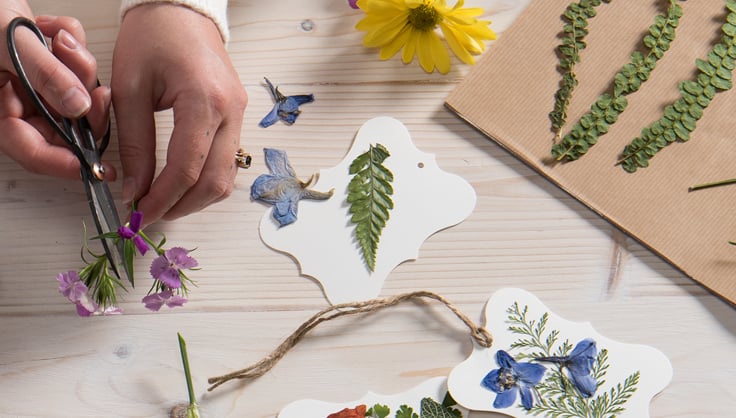4 Ways To Dry Flowers
Preserve the beauty of summer with dried flowers

Living in a place like Vermont, where there's snow on the ground for six months of the year, gardening is about memories as much as it is about digging and planting and weeding. So I preserve the memories of my garden in journals, photographs and paintings that I can pore over when the ground is frozen.
Another way that I keep some of my garden's beauty around me is to dry flowers. As summer draws to a close, I gather flowers to make wreaths and dried arrangements for the house, and I squirrel away extra material for gifts. This ritual helps me say 'goodbye' to this year's garden - but not completely.
There are six flower-drying techniques to choose from. Here are the easiest ones (the ones I use):
1. Air-Drying
Many kinds of flowers can simply be cut, bundled with a rubber band, and hung upside down from a nail or coat hanger. They'll usually be dry in three to four weeks. If find this method works well for rosebuds, lavender, hydrangea, zinnias, salvias, globe thistle, artemesia, astilbe, larkspur and goldenrod.
Air-dried flowers should be picked while in loose bud or just as they open. Remember that they will continue to open as they dry. If the flower is too mature, it will drop its petals when dry.
Remove excess foliage from the stems before you dry them. Then hang small bundles upside down in a place that's warm, but not over 85 degrees. The darker the better, as light will fade flower colors. Good air circulation is important. If the air is too humid and stagnant, the petals will take too long to dry and colors will change to brown. Try a closet, attic, garage or shed.
If the flowers have stems that are weak or crooked, you can wire them before drying. (It's harder to do once they're dry.) Cut floral wire to length and bend one end to form a small loop. Remove most of the real stem. Push the non-looped end of the wire into the center of the flower head and pull through gently until the loop is imbedded in the flower head.
Everlastings
These are annual flowers that are usually grown specifically for drying. The flower heads have a very low moisture content. Just cut the stems and hang to dry. Common everlastings that I've had success with include: statice, strawflowers, gomphrena, nigella, lunaria, bells of Ireland, celosia, amaranth, Chinese lanterns and winged everlastings (Ammobium).
Some everlastings have weak, short or crooked stems and will need to be wired before they?re dried (see above). Strawflowers and Ammobium should be picked and wired when the flowers are only about one-third open.
Seed Pods, Grasses and Wildlings
Collecting and arranging these materials is a fall ritual I really enjoy. These plants always look great together, but many also look good combined with garden flowers. Some people spray paint seedpods and grasses with gold or silver. You can also spray them with hairspray or a floral fixative.
Good candidates in this category include: milkweed, ornamental grasses, cattails, the stiff, brown fertile fronds of Ostrich ferns, allium and opium poppy seed-heads, and bittersweet.
Here's a quick run-down on three other ways to preserve flowers: silica, pressing, and microwave drying.
2. Silica
Fleshy flowers like irises, orchids and peonies are hard to preserve unless you use silica. This powdery, sugar-like material is sprinkled over and around individual blossoms that have been placed inside a box or tin. The silica gradually absorbs the moisture from the blossoms, leaving them perfectly intact. When the flower is dry, you gently pour off the silica and can re-use it indefinitely. This technique is a bit too fussy for me, but if you have a few choice blooms that you want to preserve, give it a try. You can usually find silica at craft stores.
3. Pressing
When winter comes, I always wish I'd taken the time to fill my flower press. Pressed flowers are great for making greeting cards or bookmarks, or to slip into a letter. My neighbor gave me a framed bouquet of pressed flowers that she picked in my garden the day my first son was born. What a treasure!
Flowers with single petals are easiest to press: coral bells, hydrangea, pansies, Queen Anne's lace, ferns and small grasses. Fleshy petals or thick centers are tricky and won't work unless you separate the petals. I suggest experimenting. Sometimes you'll be surprised by how well a flower presses.
To use a regular wood press, just lay the flowers between layers of absorbent paper, and apply pressure with straps, clamps or screws. An encyclopedia or phone book also works, though you?ll sometimes have problems with the ink coming off onto the petals.
4. Microwave Drying
I only use my microwave for warming leftovers. But I've heard it also works great for drying flowers. You can put blossoms into a plastic container filled with silica, or just lay them between sheets of paper towel. A Microwave Flower Press will give you pressed flowers in a few minutes rather than a few weeks.
I hope this inspires you to get out into your garden and save some colorful blooms to enjoy this winter.
Print this Article:
Get the Dirt
Stay up to date on new articles and advice. Please fill out the information below.
